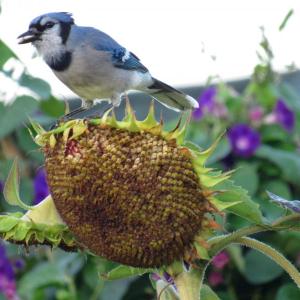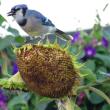Kristen Lindquist: In Praise of Blue Jays
 At the source: Blue Jays prefer seeds and nuts. (Photo courtesy Kristen Lindquist)
At the source: Blue Jays prefer seeds and nuts. (Photo courtesy Kristen Lindquist)
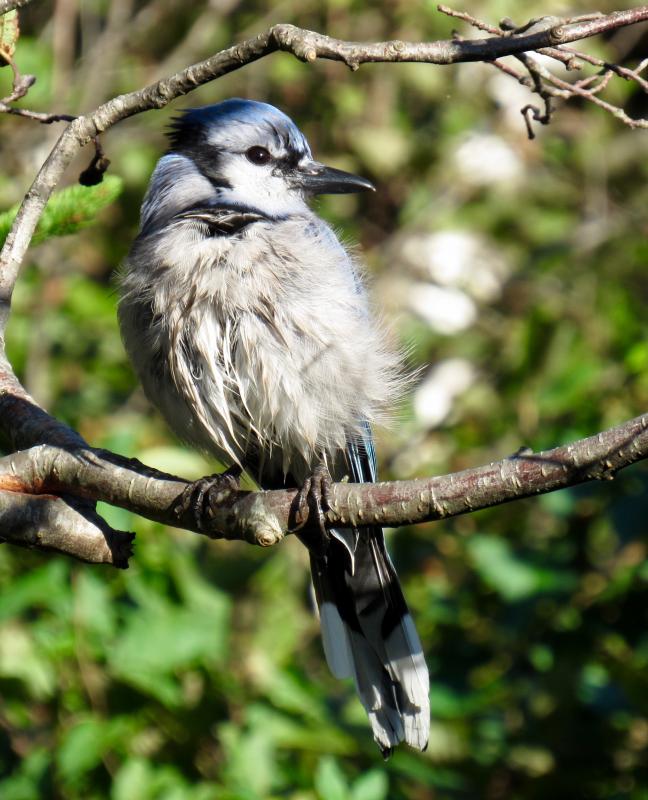 Ruffled from a recent bath, this jay shows no anxiety at my presence. (Photo courtesy Kristen Lindquist)
Ruffled from a recent bath, this jay shows no anxiety at my presence. (Photo courtesy Kristen Lindquist)
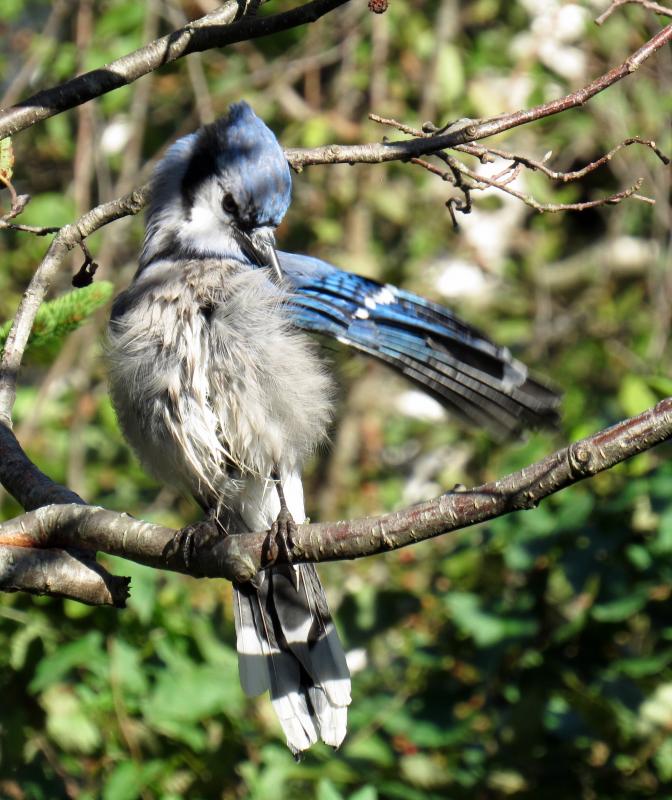 (Photo courtesy Kristen Lindquist)
(Photo courtesy Kristen Lindquist)
 At the source: Blue Jays prefer seeds and nuts. (Photo courtesy Kristen Lindquist)
At the source: Blue Jays prefer seeds and nuts. (Photo courtesy Kristen Lindquist)
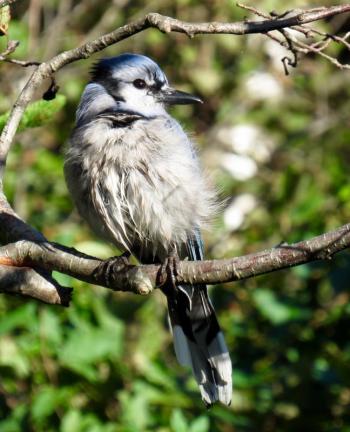 Ruffled from a recent bath, this jay shows no anxiety at my presence. (Photo courtesy Kristen Lindquist)
Ruffled from a recent bath, this jay shows no anxiety at my presence. (Photo courtesy Kristen Lindquist)
 (Photo courtesy Kristen Lindquist)
(Photo courtesy Kristen Lindquist)
Why admire the obnoxious Blue Jay, who hogs the bird feeder and displays poor table manners? This sassy bird has more going for it than you might think, and deserves our interest and attention. So let us now praise the ubiquitous Blue Jays...
Because they are intelligent.
Blue Jays belong to the corvid family, which also includes crows, ravens, and magpies. Corvids are known for their intelligence and their vocal abilities. Just one look in a jay's curious, beady black eyes and you can tell there's more going on in that little bird brain than in your average songbird. Jays live within tight family groups and are thought to mate for life—which for a jay can be more than twenty years.
Corvids are also known for their vocal abilities. The Blue Jay's frequent, raucous "Jay! Jay! Jay!" is recognizable by most. The bird also possesses an amazing repertoire of other, more or less musical sounds, including a high-pitched, liquid "toodle-oo," rattles, soft purrs, squeaks, and such noises as a beeping imitation of a car door being unlocked.
I have often been fooled by these talented mimics, which readily imitate the calls of other birds: Red-tailed, Broad-winged, and Red-shouldered Hawks, Osprey, and even Red-bellied Woodpecker. Some suggest that the jay mimics a hawk to chase other birds from the feeder or to scare away those too close to a nest. But I've heard jays calling like an Osprey or a Red-shouldered Hawk deep in the woods, miles from any feeder and long after nesting season. I think they do it just because they can, for their own amusement.
Because they are my neighbors.
Blue Jays are intermittently migratory, especially in the northern part of their range. But not all of them leave town in the fall.
The birds in my neighborhood, probably a family group, seem to stick around all year, with a pair often nesting in or near our yard. In fact, a few years ago an imprudent, probably inexperienced pair built their sloppy twig nest in the too-small inner corner of the roof over our front doorstep. The brooding female got very used to our comings and goings, and we kept a close eye on what was happening in the nest. But the living experiment ended sadly (for us, at least) when their one nestling fell out of the nest and suffered fatal injuries before it fledged.
No matter the season, I can always count on the local gang of jays. Now that nesting season is over, family groups are back together and louder than ever. I've been hearing their calls outside, in fact, the entire time I've been writing this piece. I see them daily and have grown fond of their bold and brassy behavior, even if they do steal all the peanuts immediately after we fill the feeders.
Because they alert me to visitors in my yard.
The brash Blue Jay seems to be almost constantly making noise, the exception being when it is on or near its nest. But I keep one ear cocked for when the local birds seem to be on especially high alert. Flocks of jays, like their cousin crows, will mob other birds or animals they consider a threat; several birds will perch or repeatedly fly at or near the target creature, making a big racket, until the interloper moves on or they get bored. While the neighborhood crows seem to take on the larger threats—we've seen them mob eagles, hawks, owls, and once even a fox—Blue Jays will get in on the action too.
Often it's just a cat passing through the yard that triggers the jay mob, but sometimes it's something more unusual. One morning I was awakened early by the clamor of mobbing jays in the back yard. Because they sounded so close, I couldn't resist seeing for myself what was back there. Sure enough, a young porcupine, blithely ignoring the squawking birds, was slowly climbing our maple tree.
Because they help plant trees.
Resident Blue Jays will cache acorns and other seeds and nuts for future meals. This behavior in itself reflects a certain brainpower, for the birds must be able to remember where they've stashed these food stores. If you watch a jay at the feeder, it will seemingly gobble down seed after seed. What a pig, you might think. But if you observe carefully, the jay's throat will gradually extend, until eventually the bird flies off with a throat full of seeds to cache for the future. They don't remember every acorn they've buried or stashed, however, so in this way jays have unwittingly evolved as a primary propagator of oak and beech trees.
In general, most of the Blue Jay's diet is nuts and seeds, with some insects thrown in for protein and variety. But the bird is opportunistic, grabbing eggs, baby birds, or even small rodents when it can, in addition to scraps from the suet feeder or compost heap.
Because their plumage is beautifully blue, without having any color of its own.
As with many blue birds, including bluebirds and Indigo Buntings, the Blue Jay's feathers are not actually blue. Oh, they look blue, but they contain no blue pigment like a cardinal's feathers, for example, contain red pigment. What causes us to see the jay as blue is all structural: the way its feathers are physically structured causes the light hitting the feather to reflect back to us as blue. And what flashy, almost iridescent blues, violets, and purples they are! We tend to take the familiar for granted, but next time a Blue Jay comes to your feeder, take a little time to appreciate its colorful, strikingly patterned self.
Because there's nothing like seeing a bright blue bird against a background of the yellow and red leaves of fall.
 Kristen Lindquist is an amateur naturalist and published poet who lives in her hometown of Camden.
Kristen Lindquist is an amateur naturalist and published poet who lives in her hometown of Camden.
Migrating flickers and falcons
Orchids —They're not just in the tropics
• Meditations on an unlikely harbinger of spring
• Meditations on the Snow Goose
• Sky-watching during the holiday season
• Understanding the Aurora Borealis
• Get to know the constellation Gemini
• Celebrate September’s full moon
• Northern Sky basics with the Big Dipper
• Early Christmas morning: Look up! A full moon, and Orion bright in the sky
Event Date
Address
United States

